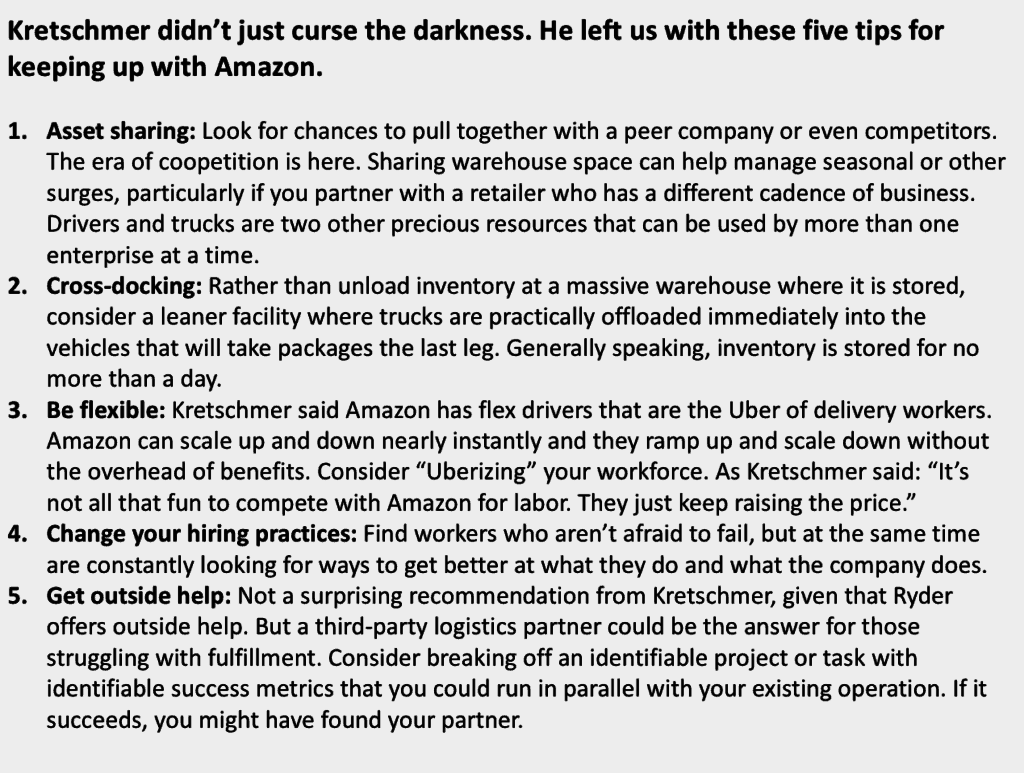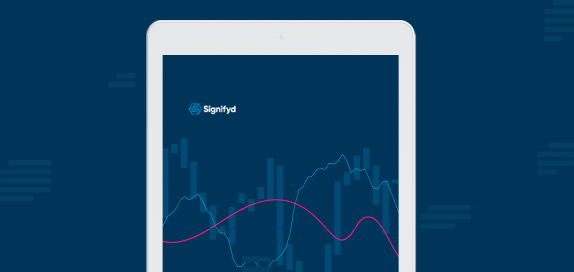There are few corners of life — and certainly few corners of ecommerce life — that have not been upended by Amazon and it’s omnipresence.
For those running retail supply chains, the rise of Amazon means that, more than ever, a shipment’s final destination isn’t a store’s back dock, but a customer’s front door.
It’s a big change and a big challenge. And if retailers want to keep up with Amazon and customers’ expectations, they need to move away from old-school supply chain tactics to tactics made for what Tom Kretschmer calls “the Now Economy.”
Kretschmer, a vice president overseeing retail at Ryder Systems Inc., spoke recently during “The Amazon Effect and Your Supply Chain,” a webinar moderated by Bob Trebilcock, editorial director of Supply Chain Management Review. The discussion focused on the rapid transformation of the supply chain field, given the way Amazon has empowered consumers and raised expectations. It also included a few ideas about how those not named Amazon might compete. We’ll get to those in a minute.
“It’s the Now Economy,” Kretschmer explained. “And it’s driven largely by the Amazon Effect. Our complexity in the supply-chain business has skyrocketed exponentially. To keep pace with the Amazon Effect, supply chain folks and managers are forced to change strategies so they don’t lose loyal customers.”
Much has been written about the crushing pressure that Amazon is exerting on competing merchandisers, marketers, executives and brick-and-mortar stores themselves. But the behemoth from Seattle is also turning the world of fulfillment upside down.
Instead of delivering from point A to point B, retail supply chain operations now must deliver from point A to points B, C, D, E, F and on and on, with each point now a home address.
“Now, shipments are smaller and more frequent,” Kretschmer said. “In order to fulfill customer demand and keep up with the Amazon Effect. Everyone at every stage of the supply chain is trying to keep up.”

The Amazon effect drives consumer expectations
A quick review: Amazon with its mountains of data, years of ecommerce experience and beyond-vast inventory has changed everything about retail. Amazon dictates consumers’ expectations.
“They want the order now. They want it at the doorstep when they want it. It’s got to be perfect. The expectation is on time and in full.”
No doubt Amazon has radically recast consumer culture.
“The way we shop now is around how fast our fingertips can press the checkout button,” Kretschmer said.
And there is mobile commerce, the Internet of Things and Alexa, which (who?) is literally at our beck and call.
But the way consumers think about shopping also has changed dramatically. No longer do those doing the selling have all the information. No longer do they dole it out as it suits their needs. The internet has opened up shopping to transparency.
Now that every human comes with a smartphone attached, comparison shopping is much more common. But, Kretschmer said, “people are not just comparison shopping on cost. They are shopping on service — how quickly can I get my new washing machine to my house?”
So, no pressure.
“We’ve gone from seven-to-10 days delivery, to two hours,’’ Kretschmer said.
Or maybe we’ve gone from seven-to-10 days to 39 minutes, as demonstrated by this YouTube video that Amazon Prime Now executive Stephenie Landry showed at Shoptalk last year.
Retailers’ best bet in the face of Amazon, Kretschmer said, is to embrace innovation — and not just in a gauzy, mission-statement kind of way. Retailers need to be investing in the future.
“Amazon is constantly driving changes in the way products are delivered,” he said. “They simply have a relentless pursuit of innovation. Companies that will succeed are companies that will mirror that relentless pursuit of innovation.”
Without saying so directly, Kretschmer said retailers need to act like a Silicon Valley startup: They need to invest and embrace innovation, he said. They need to iterate, fail fast and analyze the data to see what works and what doesn’t.
“We’ve got to get to test, learn and scale, quick — quicker now than we ever have before.”
Kretschmer said digital retailers are hungry for technical solutions that can help them anticipate changes and needs in their supply chains.
“Rapid technological advances are occurring in data analytics, predictive, prescriptive, mobility, APIs, cloud computing,” he said.”
Automation is working across ecommerce operations
And why not? Digital retail has been bulking up on automation and data-driven strategies. Retailers want to know what’s going to happen before something happens. The desire is stretched across the retail operation, from wanting to know what brand of shirt that customer wants to buy, to knowing which summer dress should be placed in the top position on a web page, to knowing where incoming inventory is and when it will arrive, to knowing whether an order was placed by a legitimate customer or someone scamming the system, to knowing when an order will arrive at a home.
Leading retailers have turned to machines to tackle the need to know on a scale that can’t be maintained by humans.
“I think we’re reaching an inflection point with robots and artificial intelligence and the shared economy,” Kretschmer said.
There is no slowing down. If you think digital retail and the way consumers shop has transformed radically in the last decade or so, wait until you see what is coming. 3D printing could usher in an era where consumers not only order from home, but actually manufacture at home the products they’re buying.
“Of course,” Kretschmer cracked, “you’d have to order the material cartridge from Amazon.”
Robots, as you know, are here and Kretschmer said Amazon is running away from the pack in terms of using them in fulfillment. And drones? Well, regular drone deliveries might seem a ways off, but Amazon is famously on it.
“I can’t see a love seat flying over my house, or a refrigerator anytime soon,” he said.
But smaller deliveries might be here before we know it. And if anybody does figure out how to fly a fridge to you, it’s likely to be Amazon.
“Given what they’ve done,” Kretschmer said, “I wouldn’t put anything past them.”
No doubt the pace of change in supply chain and retail in general will continue to accelerate, pushed along in large part by Amazon. It’s a fact of retail life and a reason for competitors to constantly raise their game.
Photo by iStock.
Mike Cassidy is Signifyd’s lead storyteller. Contact him at [email protected]; follow him on Twitter at @mikecassidy.











